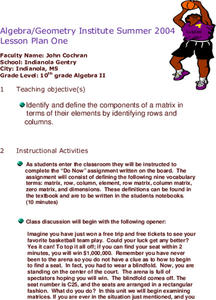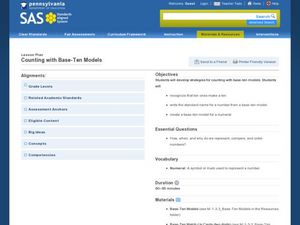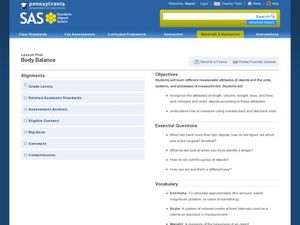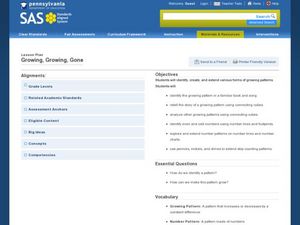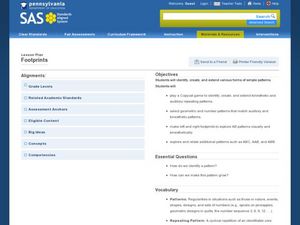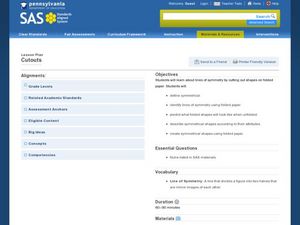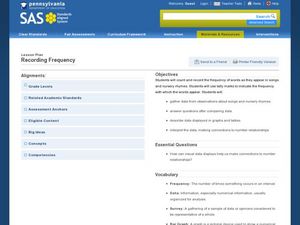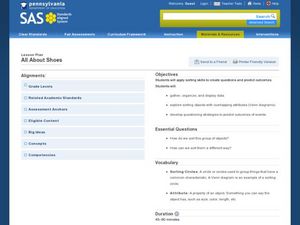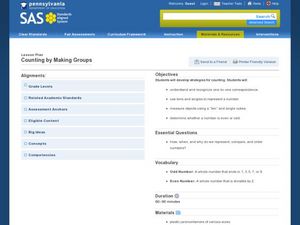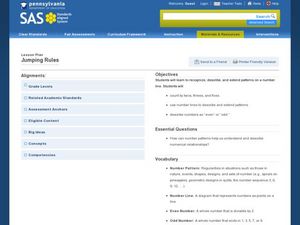Illustrative Mathematics
Counting Squares
Challenge young mathematicians' understanding of squares with this geometry puzzle. The task is simple, identify as many squares as possible in a 3x3 array. Allow learners to work independently or in pairs as they search for squares,...
Curated OER
Building Arrays Using Excel Spreadsheets
Students create arrays using Microsoft Excel. In this technology-based math lesson, students expand their knowledge of multiplication by creating arrays on the computer using a spreadsheet program such as Microsoft Excel.
Curated OER
Matrices
Learners explore matrices. Given a particular situation, they discover the make-up and design of a matrix. Students identify examples of rectangular arrays used in real world situations. They solve oral problems in class.
Pennsylvania Department of Education
Volume of Compound Figures
Fifth graders use patterns, models and relationships to solve equations. In this equations lesson, 5th graders define vocabulary for equations and complete worksheets explaining variables and solving problems.
Curated OER
Number Patterns
Help your students to identify even and odd numbers. In this number sense lesson, they read the book Madeline and use counters to identify which number has a "partner." Learners write down odd and even numbers on a whiteboard.
Curated OER
Counting with Base - Ten Models
Help your kids develop strategies for counting. In this base-ten lesson, learners use matching cards, base 10 blocks, and dry erase markers and boards to examine the base 10 counting system.
Curated OER
Many Ways to Represent Our Data
Demonstrate several ways to represent data with your class. They will use surveys to gather data and display the data using tally charts and graphs. Then answer questions according to the data.
Curated OER
Body Balance
Examine measurable characteristics of objects to build an understanding of the different ways you can discuss an object's size when comparing it to other objects. After whole group instruction, the class compares and organizes several...
Curated OER
Growing, Growing, Gone
Budding mathematicians identify growing patterns in numbers and songs then create their own patterns. They look at number patterns and language patterns and then create their own using money and footprints.
Curated OER
Shapes from Shapes
Geometric shapes are really cool. Examine triangles, quadrilaterals, trapezoids, rhombuses, parallelograms, pentagons, and hexagons with your class. They draw large shapes and small shapes then compare them to understand their shapely...
Discovery Education
Sonar & Echolocation
A well-designed, comprehensive, and attractive slide show supports direct instruction on how sonar and echolocation work. Contained within the slides are links to interactive websites and instructions for using apps on a mobile device to...
Curated OER
Junk Sort
Students analyze objects by one or more attributes. In this sorting lesson, students use manipulatives and string or yarn to create a sorting game. Students read books and items from the classroom to sort.
Curated OER
Footprints
Students explore patterns. In this patterns geometry lesson, students identify and extend patterns including body parts, movement, geometric shapes, noises, and footprints. Students create and share an original pattern.
Curated OER
Make a Match
Second graders examine the relationship between addition and subtraction. In this number sense lesson plan, 2nd graders practice their computation skills and use various strategies (including manipulatives...
Curated OER
Solving Problems
Second graders become familiar with need strategies for computation of money problems and estimating sums. In this computation lesson plan, 2nd graders solve real life problems to understand estimation and money problems.
Curated OER
Cutouts
Students identify symmetry in shapes. For this geometry lesson, students fold paper to identify lines of symmetry. Students create various symmetrical shapes using folded paper.
Curated OER
Recording Frequency
First graders analyze nursery rhymes and gather data about word frequency. In this frequency lesson, 1st graders create graphs and tables. Students interpret the data.
Curated OER
How using number patterns help us add or subtract
Second graders use a number line to understand multiples. In this number line lesson, 2nd graders use a floor size number line and calculate problems with multiples. Students complete a worksheet with multiples.
Curated OER
All About Shoes
Students sort shoes. In this sorting instructional activity, students use shoes to explore attributes and practice sorting. This instructional activity encourages the use of a Venn Diagram to aide in student sorting.
Curated OER
Counting by Making Groups
First graders represent, compare, and order numbers. In this counting skills lesson, 1st graders use manipulatives to demonstrate one-to-one correspondence and to represent numbers. This lesson includes a teacher script to guide the lesson.
Curated OER
Jumping Rules
First graders practice identifying number patterns. In this basic patterns lesson plan, 1st graders use a large number line and jump to certain numbers to create, identify or extend a pattern. This lesson plan includes a script to guide...
Curated OER
Mystery Graphs
Learners study graphs and learn how to display information into a graph. In this graph lesson plan, students construct a graph of their own sorted data, and pick out things in graphs that are inconsistent.
Curated OER
Partial Products
Pupils use the partial products algorithm to complete multiplication problems. In this partial products lesson plan, students are introduced to the algorithm and connect the relationship to multiplication and division problems.
Curated OER
Sketch Up
Students estimate and measure exact. In this geometry lesson, students create different object in three-dimensional pattern. They use SketchUp to create their shape and perform measurements on their shapes.


